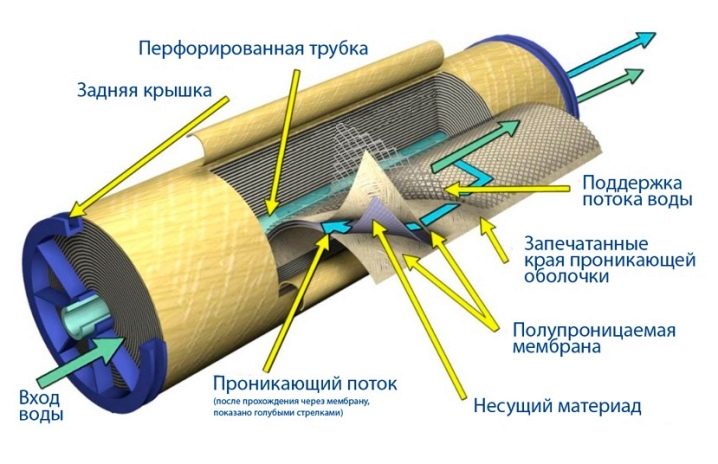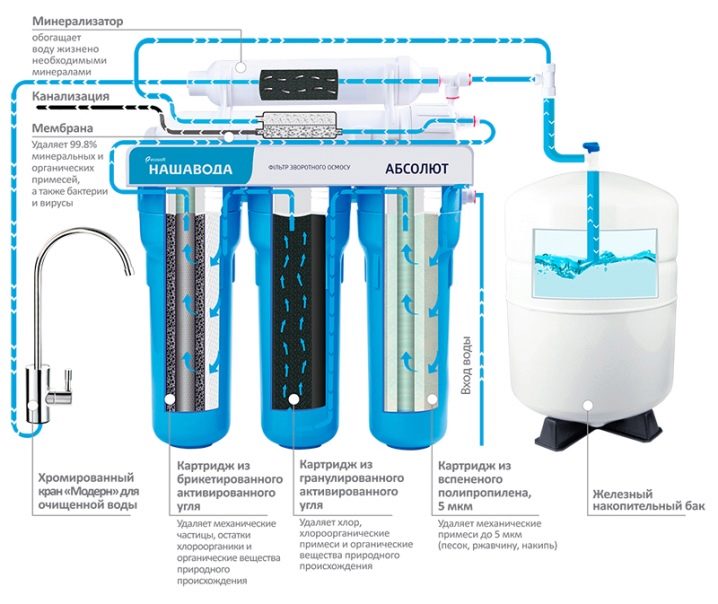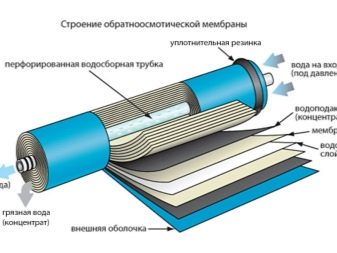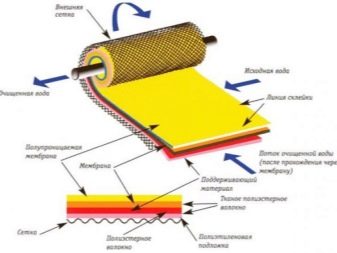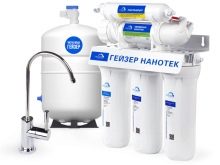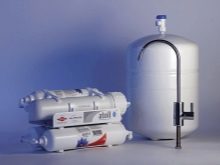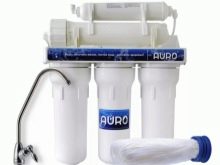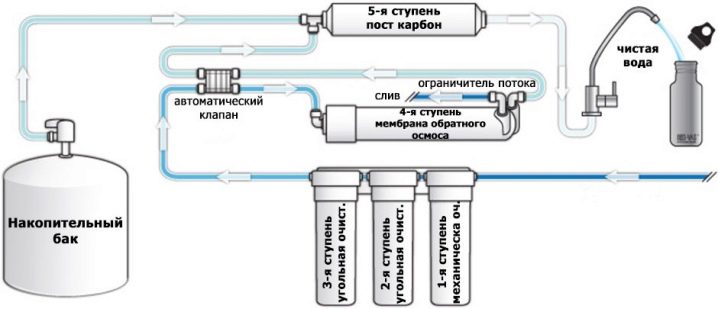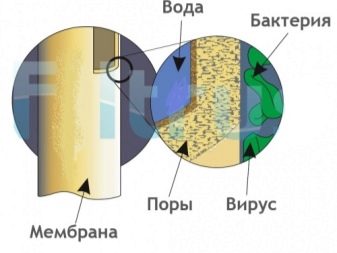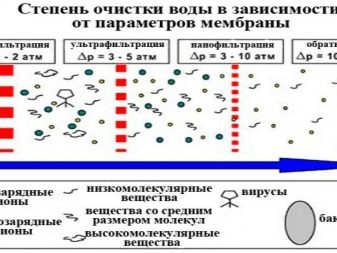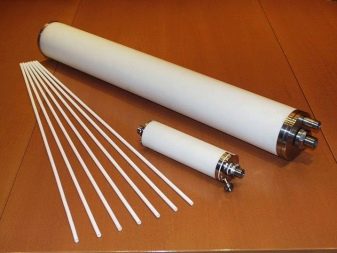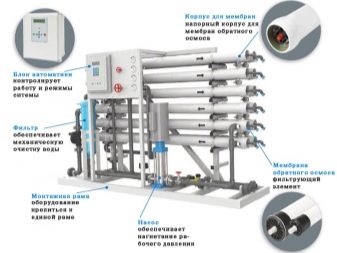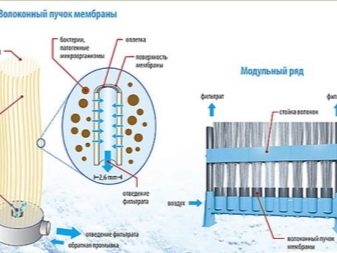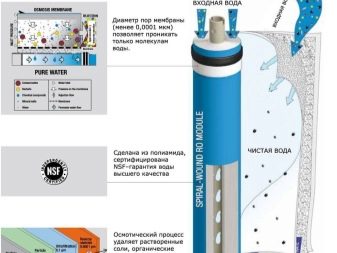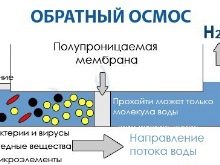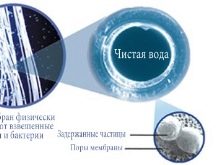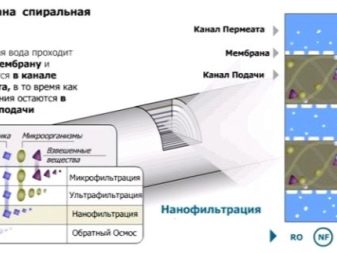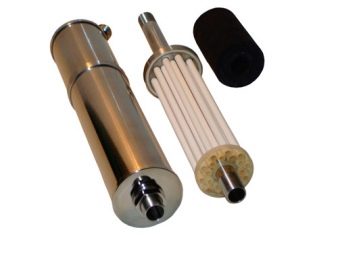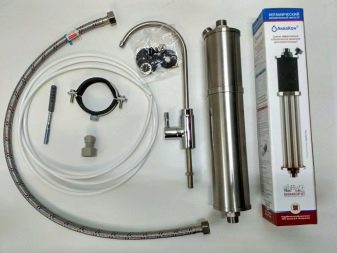Membrane filters for water treatment: design features and principle of operation
The current water supply system has significantly progressed and improved, the person has the opportunity to create a completely automated complex, without spending a huge amount on it. The quality of water, unfortunately, has not improved, and even worse. This necessitates the use of special filters that must be present in every home. The most popular membrane filters, characterized by high efficiency, they allow for water purification at the molecular level. To better understand the merits of this mechanism, you need to get to know him better.
Distinctive features
It is believed that these filters carry out a rough method of water purification. They are used to clean the liquid, mainly water, from various harmful substances.
The main element responsible for filtration is the membrane. The size of its pores can be varied, which directly affects the quality of the cleaning carried out. All contaminants leave the water that has passed the filtration, since they will not be able to pass through the membrane and linger. As a result, a person receives purified water.
Purification systems made with membrane filters are often used in domestic conditions, as well as in order to obtain the most pure water used in industry or medicine. Such systems are often used to perform seawater desalination or wastewater treatment. The presented system can also be applied in emergency situations, while its resource of functioning allows using track membranes to be reusable.
The cleaning system is connected to the pipeline through which water enters the house or apartment.
The similar system consists of several elements:
- The filter performing the primary cleaning.
- Two elements with special cleaning cartridges. In the first is granulated coal, and in the second block.
- Membranes, the pore cross section of which may be different, as will be described in more detail below.
- Tanks for accumulation of purified water.
- An automatic valve that is required to shut off the water supply when the storage tank is filled with purified liquid.
- The cartridge provides additional water mineralization.
Filtering occurs on a specific technology. It is important to note that the design and content may differ from each manufacturer and depending on the needs of the purchase, which directly affects its cost.
What causes high demand?
Considered systems are characterized by high efficiency. Due to the small cross section of the pores, the water that has passed through the cartridge becomes completely clean. Membrane filters used for water purification are highly expensive, which is their main disadvantage, however, They have many advantages, including:
- use and maintenance are characterized by ease and does not require much effort;
- Purified water is of excellent quality. It can be drunk directly after filtration without boiling;
- allows you to achieve the required mineralization and retains the necessary for human salt;
- There are certain models of filters under consideration that can be used when it is not possible to connect the device to the pipeline.
Systems that are installed to clean sewage make contaminated liquid safe for humans. It can easily then be drained to the ground. The specific disadvantage of this device is the need for a fairly frequent change of the membrane and some filter elements that usually do not last more than 3 months. This is not a significant disadvantage, since almost all types of filters that exist today require such a frequent replacement.
Species
All existing types of membranes should be considered according to various criteria.
By the level of implementation of cleaning
Water or gas can quietly pass through the membrane, however, other particles will be trapped.Large inclusions are removed from the water through mechanical and other types of filters. Membrane filtration is used to clean small particles.
According to the pore sizes, the following types can be distinguished (pore sizes are in microns):
- micro- (0.1-1), ultra- (0.02-0.1), nanofiltration (0.001-0.02);
- with reverse osmosis (0.0001-0.001).
Microfiltration membranes are capable of removing significant contamination from water. This category includes those particles due to which the water becomes turbid. Substances that have been dissolved in water cannot be removed by this filter. The second option (ultrafiltration system) is capable of retaining colloids, various microorganisms and high molecular weight inclusions. Such purification allows you to remove from the water various impurities, however, the salt composition, necessary for a person, is preserved in it.
Therefore, to soften hard water, such a system is not suitable. To make water softer and eliminate hardness, nanofiltration is required. The latter type of membrane is able to hold all sorts of contamination of various sizes.
By design
In this case, the membranes differ in their form:
- Disc shape. It is characterized by low pressure sensitivity. It can be applied up to a pressure of 1000 mm water column. It can be made in three different versions. The disk-shaped membrane can be made of one component, be a porous fabric, or have 2 layers (porous and working).
- With tubular elements. Such membranes imply a tube made of a porous material. It can be made of various materials, however, the most common are plastic and ceramics. The diameter of this tube can be several millimeters or reach 2 cm. The walls of the tube can be symmetrical or not. The first method provides the same thickness and porosity along the entire length, and the second implies that a certain part of the walls is more dense and has a smaller number of pairs than the other. Water enters this porous tube with a pump. It passes through the pores and, accordingly, is cleaned. The filtered liquid accumulates in the tank, and the dirty is sent to the sewer.
- Roll. This filtration system implies a drainage tube, which is wrapped in a filter layer. Drainage pads in this situation on both sides cover the membrane, because of which a layer with three layers turns out to be screwed onto the tube. This mechanism implies that, on the one hand, polluted water flows into the system. Then she goes through the process of purification and goes to the tank. The flow of fluid is divided into 2 parts. One goes through the stage of purification, and the second washes away the pollution, which is sent to the sewage through the end part. This design is characterized by convenience, there is a thin working layer, which improves the performance of this filter. Clogging is extremely rare.
- Hollow fiber, consisting of a set of tubes with a small diameter. Since they are of compact size, it is possible to increase the number of these tubes in the device, which allows to increase the amount of filtered water. As disadvantages of such a system, it is necessary to single out frequent clogs and relatively complicated cleaning. In order to avoid such situations, it is necessary to carry out a high-quality cleaning, which can remove large contaminants.
Functioning
The membrane cleaning system is one of the best since the filtration quality is high. It is capable of removing various contaminants and viruses from a liquid, but at the same time preserving its beneficial properties and necessary trace elements.
At the exit, a person receives natural and completely purified water, which is biologically full. It is rich in minerals that are required for the human body. The system has one inlet through which water enters the filter for purification, and 2 outlets, which is caused by the fact that one outlet is for clean and purified water that is sent to the storage tank, and the second outlet is required to bring contaminants to the sewer.
The considered device is the best and affordable tool for home use, however, the presented systems are used in the industrial sector. Such water does not need additional treatment, it can be drunk immediately after filtration, since the membrane has removed all viruses, microorganisms and bacteria, and the salts required for humans have been preserved.
The cleaning process is carried out in 5 stages:
- There is a pre-cleaning, in which there is a mechanical purification of water. At this stage, most of the chlorine used for disinfection is eliminated.
- Water is filtered through reverse-osmosis membranes, so you can clean it of various contaminants.
- Filtered water accumulates in a special tank.
- Next, the fluid is fed through a special valve connected to the storage tank.
- In the process of distributing water, you can perform additional mineralization. To do this, you need to install a special cartridge for mineralization, through which water will pass just before serving.
You can increase the performance of the membrane if:
- increase the area of the treated surface;
- increase pressure;
- reduce its thickness;
- raise the temperature of the water that is being filtered. One degree Celsius can increase flow to 3%.
Today, manufacturers offer membrane filters that operate on a different scheme. They are installed in a container with contaminated water and clean water flows through a tube into another container.This option is great for hiking and when there is no possibility of connecting the system to the water supply.
Inorganic-type sediment can be removed from the membrane by acidic means. Biomass and organic sediments are washed through the use of alkaline compounds. You should not use sulfuric or nitric acid, because they can harm the filter of the type in question.
Selection tips from experts
When choosing a membrane filter, you need to pay attention to the following points:
- Initially, you need to decide on the purpose for which the device is purchased.
- It is recommended to carry out a water analysis before purchasing a membrane filter, which will reveal its shortcomings and select the appropriate filter.
- The price of the membrane is directly proportional to its functions.
- In order to soften hard water, it is worthwhile to install a nanofiltration membrane type.
- Most of the proposed filters today, for example, ceramic, of the type in question do not need an additional tank for collecting filtered water.
- To regularly receive purified water that can be drunk immediately after filtration, it is necessary to control the cleanliness of the filter, which must be periodically cleaned.
- If you chose the reverse-osmosis membrane, then additional water mineralization should be carried out, since this filtering method deprives the water of the necessary trace elements and properties that are beneficial to humans.
- To carry out the preliminary purification of water that is highly contaminated, it is additionally required to acquire microfiltration membrane.
Remember that the quality of drinking water consumed has a huge impact on the health of our body, so it is extremely important to responsibly approach the choice of filter. Cleaners must have good performance, quality block, positive feedback and an uncomplicated principle of operation.
For information on how to clean the reverse osmosis filter membrane, see the next video.

